🦿 Legs
Structure of Insect Legs, Modification of Insect Legs, Thoraxic Legs and Abdomenal Legs in Insects,
Types of legs in Grasshoppers?
Thorax
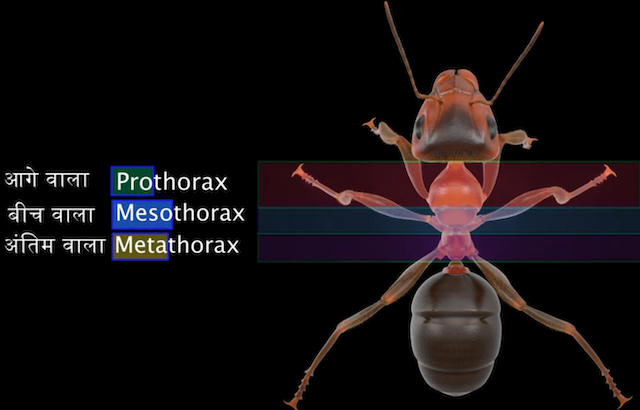
- It is second & middle part of the body consisting of three segments.
- Thorax consists of 3 segments i.e., prothorax, mesothorax and metathorax.
- All the three thoracic segments possess a pair of legs and meso and meta thorax possess one pair of wings. Meso and meta thoracic segments together known as pterothorax. (From Greek pteron means wings)
- Thoracic segments are made up of three sclerites. Sclerite of dorsal region of thorax is tergum or notum, ventral region is called sternum and lateral region is called pleuron.
Insect Legs
- All the three thoracic segments of an insect possess a pair of segmented legs as locomotory organs giving the name hexapods and the class insecta as
hexapoda. - Insect leg mainly consists of 5 segments viz.
- Coxa
- Trochanter
- Femur
- Tibia
- Tarsus
- Each of the above segment is single, except the tarsus which can be from 2 to 5 segments, each referred to as a tarsomere.
Structure of Leg

Coxa
- It is the first or proximal leg segment. It articulates with the cup like depression on the thoracic pleuron. It is generally freely movable.
- It is the functional basal segment, and it is rigidly fixed to thorax or weakly articulated.
Trochanter
- It is the second leg segment. It is usually small and single segmented.
- It is very small and the second segment. It is articulated with coxa and more or less fixed to femur.
Femur
- It is the largest and stoutest part of the leg and is closely attacked to the trochanter.
- It is the largest (longest), strongest segment and is articulated with the tibia.
Tibia
- It is usually long and provided with downward projecting spines which aid in climbing and footing.
- Tibia of many insects is armed with large movable spur near the apex.
- It is equal or more than the length of the femur, articulated with tarsus.
Tarsus
- It is further sub-divided. The sub segment of the tarsus is called tarsomere.
- The number of tarsomeres vary from 2 to 5.
- Among the 5 segments, 1st segment is large, big or broad in size known as basitarsus.
Modification of Insect Legs
- The typical thoracic leg of an adult insect is adapted for running.
- Legs are modified into several types based on the habitat and food habit of insect and used for a wide variety of functions.
1. Ambulatorial

- Ambulate = to walk;
Walking Legs - E.g. fore leg and middle leg of grasshopper.
- Femur and tibia are long. Legs are suited for walking.
2. Saltatorial

- Salatorial = Leaping:
Jumping Legs - E.g. hind leg of grasshopper.
- Trochanter is fused with femur. Hind femur is enlarged to accommodate powerful extensor muscles of tibia which are used for leaping.
- Tibia is long and slender. Two rows of spines are present along the ventrolateral edges. It is heavily sclerotised and rigid since the force of leaping is exerted against it.
3. Cursorial

- Cursorial = adapted for running,
Running Legs - E.g. all the three pairs of legs of cockroach. Legs are suited for running.
- Femur is not swollen. At top speed, a cockroach moves 4.6 Km/hour.
4. Scansorial

- Scansorial = Climbing;
Climbing or Clinging Legs - E.g. all the three pairs of legs of head louse (जूं)
- Legs are modified for clinging to the hairs of its host. Tibia is stout and at one side bears a thumb like process. The tarsus is single segmented.
- There is a single large claw that usually fits against a thumb like process which forms an efficient mechanism for hanging to the hairs of host.
- Tarsus and pretarsus work against the thumb in much the same way as the human forefinger works against the thumb in grasping an object.
5. Fossorial
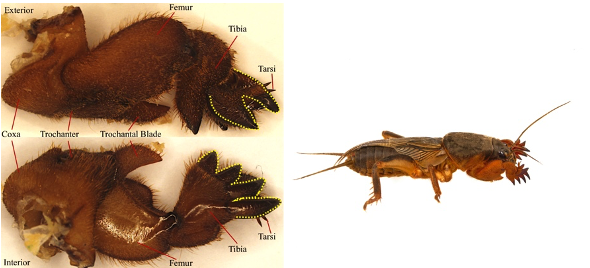
- Fossorial = Digging;
Burrowing Legs - E.g. fore legs of mole cricket.
- Forelegs of mole cricket are used as cutting and shovelling implements.
6. Raptorial
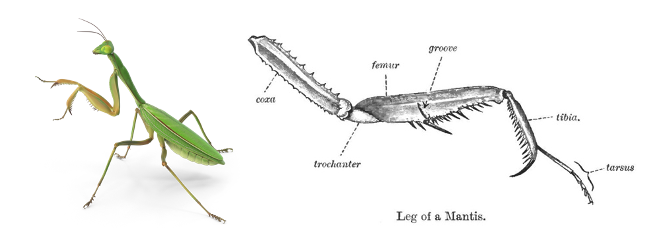
- Raptorial = predatory;
Grasping Legs. - E.g. forelegs of praying mantis.
- Forelegs are prehensile and suited for capturing the prey.
- They are of no use in locomotion.
7. Natatorial

- Natatorial = pertaining to swimming;
Swimming Legs - E.g. hind legs of water bug and water beetle.
- Aquatic insects that require modified legs to move easily through water.
- Hind legs are highly specialized for swimming. Femur, tibia and the first four tarsomeres are broad and flattened. Their edges are provided with flattened setae which serve as oars.
8. Sticking leg

- E.g. All the three pairs of legs of house fly.
- Pretarsus consists of a pair of lateral adhesive pads under the claws called pulvilli.
- The pulvilli are covered with dense mats of tiny glandular hairs called tenant hairs.
- Secretions of these glandular hairs are helpful in clinging to smooth surface and to walk upside down on the celling.
9. Basket like leg
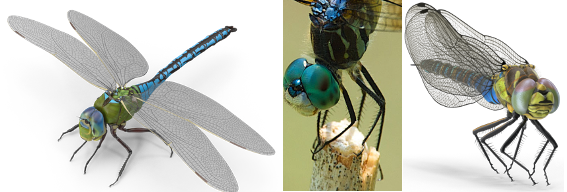
- E.g. legs of dragonfly and damselfly.
- Legs are not useful in locomotion.
- Legs are situated just behind the head and are anterior in position.
- Legs are spiny and closely placed, which are useful in seizing the prey during flight. Captured insects are kept in the leg basket.
10. Suctorial leg/Clasping leg
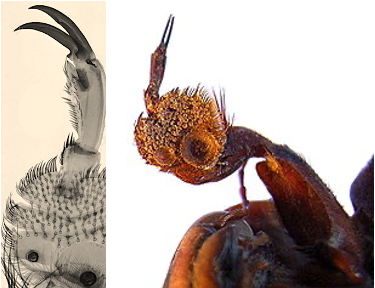
- E.g., forelegs of male water beetle
- The tarsus is flattened with adhesive discs which are useful to clasp the mate during copulation.
11. Foragial Leg

- Forage = to collect food material.
- E.g. legs of honey bee.
- All the three pairs of legs in honeybee are modified to suit their lifestyle.
Forelegs
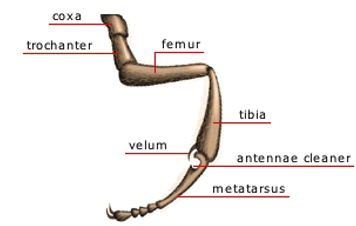
- The foreleg has three important structures.
- Eye brush: Hairs on tibia constitute eye brush which are useful to clean the compound eyes.
- Pollen brush: Bristles on basitarsus form pollen brush which is useful to collect pollen from the head and mouthparts.
- Antenna cleaner or strigillis: It consists of two structures viz., vellum and antenna comb. Velum is a movable clasp present at distal end of tibia. Antenna comb is a semi-circular notch lined with small spines. Antenna cleaner is useful to clean the antenna.
Middle legs
- It has two important structures.
- Pollen brush: Stiff hairs on basitarsus form pollen brush which is useful to collect pollen from middle part of their body.
- Tibial spur: At the distal end of the tibia, a movable spur is present which is useful to loosen the pellets of pollen from the pollen basket of hind legs and to clean wings and spiracles.
Hind legs

- It has three important structures viz., pollen basket, pollen packer and pollen comb.
- Pollen basket: It is also called corbicula. The outer surface of the hind tibia contains a shallow cavity. The edges of the cavity are fringed with long hairs. The pollen basket enables the bee to carry a larger load of pollen from the field to the hive.
- Pollen packer: It is also called pollen press. It consists of pecten and auricle. Pollen packer is useful to load pollen in corbicula.
- Pollen comb: About ten rows of stiff spines are present on the inner side of hind basitarsus. The pollen comb is used to collect pollen from middle legs and from posterior part of the body.
🐝 A bee’s primary purpose is pollination. Pollen may be used to ripen eggs or in combination with nectar to feed larvae, while nectar is a sugary substance that bees eat. Bees use their hind legs to brush, collect, and transport pollen back to the nest, depositing some on flowers as they travel and aiding in pollination.
12. Prolegs
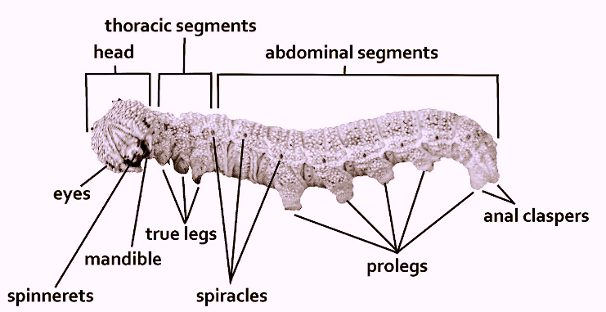
- The immature stage of exopterygotes i.e., nymph consist of only thoracic legs similar to its adult whereas that of endopterygote i.e., larva possess two types of legs.
- Thoracic legs or true legs: Jointed, present on all the 3 thoracic segments.
- Abdominal legs or prolegs: Also known as False legs or Pseudolegs.
- E.g., Abdominal legs of caterpillar.
- There are 2 to 5 pairs of abdominal legs termed prolegs in caterpillar. Prolegs are thick, fleshy and not segmented.
- They shed with last larval moult. One pair of prolegs on the last abdominal segment are called anal prolegs or claspers.
- The planta consists of hook like structures known as crochets which are used for clinging to the substrate.
References
- Insecta - Introduction: K.N. Ragumoorithi, V. Balasurbramani & N. Natarajan
- A General Textbook of Entomology (9th edition, 1960) – A.D. Imms (Revised by Professor O.W. Richards and R.G. Davies). Butler & Tanner Ltd., Frome and London.
- The Insects- Structure and Function (4th Edition, 1998) – R.F. Chapman. Cambridge University Press
- Wikipedia
Types of legs in Grasshoppers?
Thorax

- It is second & middle part of the body consisting of three segments.
- Thorax consists of 3 segments i.e., prothorax, mesothorax and metathorax.
- All the three thoracic segments possess a pair of legs and meso and meta thorax possess one pair of wings. Meso and meta thoracic segments together known as pterothorax. (From Greek pteron means wings)
- Thoracic segments are made up of three sclerites. Sclerite of dorsal region of thorax is tergum or notum, ventral region is called sternum and lateral region is called pleuron.
Insect Legs
- All the three thoracic segments of an insect possess a pair of segmented legs as locomotory organs giving the name hexapods and the class insecta as
hexapoda. - Insect leg mainly consists of 5 segments viz.
- Coxa …
Become Successful With AgriDots
Learn the essential skills for getting a seat in the Exam with
🦄 You are a pro member!
Only use this page if purchasing a gift or enterprise account
Plan
Rs
- Unlimited access to PRO courses
- Quizzes with hand-picked meme prizes
- Invite to private Discord chat
- Free Sticker emailed
Lifetime
Rs
1,499
once
- All PRO-tier benefits
- Single payment, lifetime access
- 4,200 bonus xp points
- Next Level
T-shirt shipped worldwide

Yo! You just found a 20% discount using 👉 EASTEREGG

High-quality fitted cotton shirt produced by Next Level Apparel